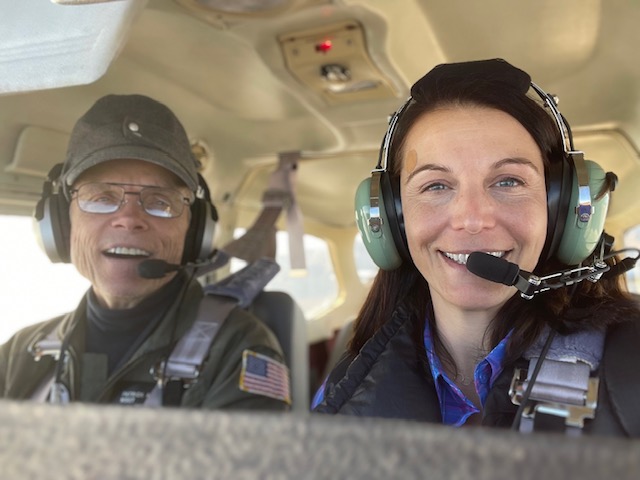Asteroid (433512) Hollyholman named after UBME Researcher
Patrick Wiggins (left) and Holly Holman (right) co-pilot in an aircraft.
Photo Credit: Patrick Wiggins
Holly Holman and Patrick Wiggins have made discoveries in their respective fields, although the subjects are on opposite scales. Holman is a biomedical engineer who studies the molecular signaling in cells of the inner ear and Wiggins is an astronomer interested in massive celestial objects lightyears from Earth. Their unlikely friendship formed via shared passions—flying aircraft and boosting gender equity in Science, Technology, Engineering and Mathematics (STEM) fields.
In November 2022, Wiggins lobbied to rename a minor planet known as 2010 DS63 to (433512) Hollyholmanin honor of his friend. A minor planet is the formal name for an asteroid, a small rocky object that orbits the sun. Professional and amateur astronomers identify thousands of celestial objects annually, but many wait years before receiving a title beyond the lifeless code assigned by the International Astronomical Union (IAU), if they get a name at all. The objects that do have names overwhelmingly honor men, a disparity that scientists like Holman and Wiggins are pushing to change.
Astronomers at the Mt. Lemmon Survey in Tucscon, Arizona first saw (4533512) Hollyholman on Nov. 22, 2009. Though Wiggins did not identify the minor planet, he has discovered and named many space objects, including 80180/Elko after his hometown, and 391795/UnivofUtah after… well you get it. He suggested Holman’s name to the IAU to pay tribute to his friend, a female scientist with impressive accomplishments and a love for the sky.
“Holly and I have been friends and fellow pilots for a few years and it’s the type of thing that astronomy types do from time to time,” said Wiggins, outreach presenter for the Department of Physics & Astronomy. “She’s worked on vaccine development, DNA viruses, and discovered a new type of cell in the canals of the inner ear, now called clinocytes.”
“I felt very honored when I heard,” said Holman, research assistant professor in the Department of Biomedical Engineering. “My interest in astronomy started as an undergrad when I learned of using star plots to determine the day, month and year. We read about the Copernican Revolution and that really sparked my lifelong interest in astronomy and science. I even named my cat after Copernicus,” said Holman. “I’ve been looking up ever since.”
Holman met Wiggins through the Salt Lake City chapter of Women in Aviation International, a non-profit that offers education, scholarships and mentorship to women who are interested in working with aircraft. As an avid pilot, she hopes to contribute to the organization’s goal of boosting the number of females in aviation and STEM fields by being a role model to future aviators. Currently, only ~7% of the world’s commercial airline pilots are female. As a biomedical engineer, Holman’s shares her research with student mentees of all ages on the vestibular system.
“I study glial-like supporting cells and their signaling in the inner ear. Vestibular organs help us detect angular acceleration and gravitational forces,” said Holman. “This is particularly relevant to pilots and astronauts.”
Wiggins is renowned for discovering new supernovae, which are the explosions of massive stars as they die out and the brightest phenomena in the universe. The method of identifying minor planets, supernovae or other space objects is tedious, but straight forward.
“One takes an image of the sky and archives that as the reference image. Then additional images are taken a few minutes or hours later and the new image is compared to the reference image. The background stars don’t move but anything that does move could be a minor planet,” said Wiggins. “In the case of supernovae, images are taken days, months or even years apart.”
He used this technique on Nov. 15, 2022, when he discovered a new supernova called SN 2022aaiq in the galaxy NGC 5631, located in the constellation Ursa Major.
This story was written by Lisa Potter and can be found here
